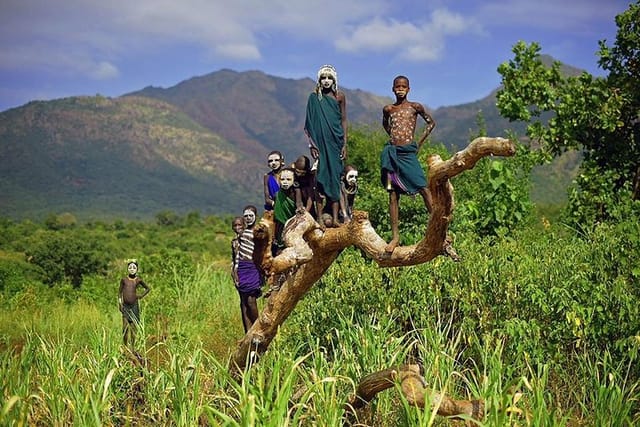
The Omo Valley, located in southwestern Ethiopia, is one of the most culturally rich and diverse regions in the world. This remote and isolated area has been home to numerous indigenous tribes for centuries. The valley lies within the Great Rift Valley and is named after the Omo River, which is central to the lives of the people here. Let's dive into the fascinating aspects of the Omo Valley in more detail:
Geographic Overview
Omo River: The Omo River runs approximately 760 kilometers (470 miles) from the central Ethiopian highlands into Lake Turkana. It provides essential water for agriculture and sustenance to the communities living along its banks.
Landscape: The Omo Valley features a mix of arid savannas, riverine forests, and lush grasslands. This diversity in landscape supports a variety of wildlife and plants.
Climate: The climate in the Omo Valley is generally hot and dry, with a rainy season from March to June, and a cooler, milder season from October to November.
Indigenous Tribes
The Omo Valley is renowned for its indigenous tribes, each with distinct languages, customs, and traditions. Some of the most prominent ones include:
Hamar: Known for their elaborate hairstyles, body decorations, and the unique "bull-jumping" ceremony, which is a rite of passage for young men.
Mursi: Easily recognizable by the lip plates worn by the women, which symbolize beauty and social status.
Karo: Famous for their intricate body painting using natural pigments.
Dassanech: Located near the Kenyan border, they are predominantly pastoralists and agriculturists.
Surma (also called Suri): Like the Mursi, they practice lip-plate ornamentation and are known for their stick-fighting as a form of sport and skill demonstration.
Nyangatom: Often seen adorned with elaborate beadwork and are typically semi-nomadic pastoralists.
Culture and Traditions
Body Modification: Many tribes engage in body modification practices such as scarification, lip plating, and elaborate body painting. These modifications are not only considered beautiful but also signify social status, age, and milestones in an individual’s life.
Traditional Attire: Rich in symbolism, attire is often handmade using locally sourced materials. Animal hides, beaded jewelry, and intricate patterns are common.
Music and Dance: Music and dance are integral to daily life and rituals. The use of traditional instruments, rhythmic dances, and communal singing strengthens social bonds.
Rituals and Ceremonies: Many tribes have rituals that mark significant life events such as birth, puberty, marriage, and death. For instance, the Hamar tribe's bull-jumping ceremony is a significant rite of passage for young men.
Challenges
Modernization and Development: The Omo Valley is increasingly facing the impacts of modernization. Roads, infrastructure projects, and new settlements are altering the traditional ways of life.
Environmental Issues: Dams and irrigation projects on the Omo River, such as the Gibe III Dam, have significantly impacted the river's flow, affecting agriculture and traditional livelihoods.
Cultural Erosion: With the influx of tourists and external influences, there is a growing concern about the erosion of these unique cultures and traditional practices.
Tourism
Attractions: The Omo Valley is a magnet for anthropologists, photographers, and tourists interested in experiencing the diverse cultures and traditions. Tribal markets, cultural festivals, and traditional villages are popular attractions.
Ethical Tourism: While tourism can bring revenue to the region, there is also an emphasis on promoting ethical tourism practices that respect the privacy and rights of the indigenous people.
Conservation
Efforts are underway to balance development and conservation to ensure that the ecological and cultural richness of the Omo Valley is preserved for future generations. NGOs and governmental bodies are working to create sustainable solutions that benefit both the inhabitants and the environment.
Conclusion
The Omo Valley is a vibrant tapestry of cultural heritage, natural beauty, and human resilience. It stands as a testament to the richness and diversity of human cultures and offers a profound glimpse into traditions that have remained largely unchanged for centuries. However, this unique legacy faces significant challenges, making preservation a critical priority.
